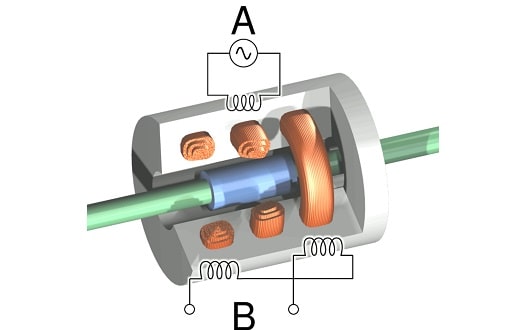You see, there are two things in engineering, the physical part (hardware), and the digital part, which is the software. If you have to tell a machine, let’s say a computer about a moving part, how would you do that? You’ll need to somehow convert the physical movement into an electrical signal so that the machine aka computer can understand it. Correct? Well, that is precisely where LVDT or Linear Variable Differential Transformers come into play.
However, they are not just signal converters, they are also used for precise measurements in various fields around the globe. But as with anything in life, it is obviously not sunshine and rainbows when it comes to these LVDTs. There is a flip side to it as well. And that is what we are onto today, here we will be going over the possible advantages and disadvantages of LVDTs. So if you are here for just that, stick around until the end. Here we go.

Advantages Of LVDT
Let’s kick things off with the possible advantages of LVDTs, shall we?
1. High Accuracy
Ever heard of the phrase “like a bullseye”? That’s what LVDTs are all about. They’ve got a knack for delivering dead-on measurements. Doesn’t matter if you’re hammering out car parts in the automotive industry or sending rockets into the stratosphere in the aerospace field, you can bet your bottom dollar on LVDTs’ accuracy. They’re basically your go-to tool when precision is the name of the game!
2. Robust Construction
LVDTs ain’t delicate darlings. Nope, they’re rough-and-ready, built to stand up to the nastiest environments and the most extreme temperatures. The toughness of LVDTs means they can keep on going in conditions that would make other devices throw in the towel. So, if you need a trooper that delivers no matter how challenging the circumstances, LVDTs have got your back!
3. Non-contact Measurement
LVDTs use some kind of sci-fi tech called electromagnetic induction to do their job, which means they don’t need to touch anything to take measurements. This hands-off approach helps the LVDTs stay in top shape for longer, reducing wear and tear, and ensuring they keep performing at their best, day in, day out. No touch means less damage and less damage means more consistent performance. Cool, right?
4. Versatility
Here’s the thing about LVDTs, they’re incredibly versatile. From the factory floor to the launch pad, these little champs can be put to work in all kinds of ways. That means whatever industry you’re in, chances are there’s a place for LVDTs. Their flexibility makes them a handy tool to have around, ready to take on whatever challenge you throw at them.
5. Going the Distance
LVDTs don’t just measure little stuff, they can handle big displacements too. This ability to cover a broad range gives them the flexibility to tackle a whole heap of applications, generating useful data that can help you fine-tune your operations and make everything run smoother.
6. Easy on the power consumption
Despite all their hard work, LVDTs are remarkably energy-efficient. They’re like the marathon runners of the sensor world, using minimal power to go the distance. That’s not just good news for your energy bills – it’s also a big thumbs up for the environment!
7. Reduced Frictional Loss
The clever design of LVDTs means there’s no physical contact between the core and the coil. Why is that good? Well, it reduces frictional loss, which in turn boosts the longevity and reliability of the device.
8. High Sensitivity
Finally, LVDTs are super-duper sensitive. They can pick up on the smallest changes in displacement, like a cat hearing a can opener from three houses away. This high level of sensitivity means you’ll get incredibly precise measurements, ensuring your data is always on point and reliable.
Disadvantages Of LVDT
And now it is time to take a look at the not-so-good side of LVDTs, ready for that? Here we go.
1. The Little Guys Slip Through
LVDTs are pretty good at tracking big movements, but they falter when the displacements get too small. Imagine trying to measure the thickness of a strand of hair with a ruler; it’s kind of like that. So, when precision matters most, especially for those teeny tiny movements, LVDTs might let you down.
2. The Magnetic Field Hurdle
You know how your compass can go haywire near a magnet? LVDTs can have a similar issue with external magnetic fields. They can throw off the LVDT’s accuracy, which is a bummer if you’re trying to make precise measurements. So, you gotta use these devices in spots where magnetic interference can be kept under wraps.
3. The Pretty Penny Problem
Brace yourself for a hefty price tag when you go to purchase and install an LVDT. This ain’t your average pocket money spend. It’s a major investment that might give some smaller businesses, especially those penny-pinching startups, a serious pause.
4. The Detail Dilemma
Even though LVDTs are reliable and accurate in their own way, they aren’t the best when it comes to detail. It’s like seeing the forest but missing the individual trees. So, when high precision is the name of the game, LVDTs might not make the cut.
5. Installation Intricacies
Setting up an LVDT isn’t a walk in the park. It’s more like assembling a complex piece of IKEA furniture with a cryptic instruction manual. It requires precision, patience, and time. If anything is off even slightly, the whole operation could end up in soup.
6. The Big for Small Trade-off
LVDTs work in a funny way. They have to measure lots of big displacements just to give a small output. It’s kind of like running a marathon for a single cookie at the end. This feature might not sit well for certain applications where efficiency is crucial.
Conclusion
That’ll do it. Now you know, not every, but key advantages and disadvantages of LVDTs. Now if you are getting started with electrical engineering, you must get to know about these little gadgets because there are literally everywhere. So yeah, good luck with that.

